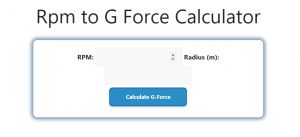About Rpm to G Force Calculator (Formula)
The RPM to G-force calculator helps you calculate the G-force experienced by an object rotating at a specific speed (RPM) with a given radius. This is commonly used in fields such as engineering, physics, and amusement park ride design to understand the forces acting on an object in rotational motion. Understanding G-force is important for safety and performance in many mechanical systems.
Formula
The formula to convert RPM to G-force is:
G-force = ((Radius × 2 × π / 60 × RPM)²) / (Radius × 9.81)
In this formula:
- Radius refers to the distance from the center of the rotation to the object.
- RPM is the rotational speed in revolutions per minute.
- 9.81 is the gravitational constant (m/s²), which is used to convert to G-force.
How to Use
- Measure the radius: Determine the distance from the center of the rotation to the object. This value is typically in meters.
- Determine the RPM: Measure or specify the rotational speed in revolutions per minute (RPM).
- Plug the values into the formula: Use the provided formula to calculate the G-force.
- Interpret the result: The result will give you the G-force, which tells you the force acting on the object relative to the force of gravity.
Example
Let’s assume an object is rotating with a radius of 0.5 meters and at a speed of 3000 RPM. Using the formula:
G-force = ((0.5 × 2 × π / 60 × 3000)²) / (0.5 × 9.81)
G-force = ((0.5 × 2 × 3.1416 / 60 × 3000)²) / (0.5 × 9.81)
After calculating, the G-force is approximately 785.4 G.

FAQs
- What is G-force?
G-force is a measure of acceleration felt as weight. It describes the force of gravity on an object moving at a particular speed. - Why is RPM important in calculating G-force?
RPM helps define how fast an object is rotating, which directly influences the G-force experienced by the object. - What is the significance of the radius in the calculation?
The radius affects how far the object is from the center of rotation, which plays a major role in determining the G-force experienced. - What units are used for the radius in this formula?
The radius should be in meters to ensure the calculation results in the correct G-force units. - Can this formula be used for any type of rotating object?
Yes, this formula can be applied to any object in rotational motion, such as amusement park rides, turbines, or vehicles. - What happens if the radius increases?
If the radius increases, the G-force also increases, because the object is further from the center of rotation, increasing the centrifugal force. - What happens if the RPM increases?
An increase in RPM will result in a higher G-force, as the object is rotating faster and experiencing more centrifugal force. - What is a dangerous level of G-force for humans?
Humans can generally withstand up to 5 Gs for a short period. Anything beyond that can cause discomfort or even harm, depending on the duration of exposure. - What industries use RPM to G-force calculations?
These calculations are used in aviation, automotive testing, amusement park ride design, and even astronaut training. - Is it possible to feel G-force in everyday life?
Yes, G-force is experienced in various situations, like taking a sharp turn in a car or on a rollercoaster. - Why is G-force measured in terms of gravitational acceleration?
G-force is compared to gravitational acceleration (9.81 m/s²) to help quantify the acceleration felt as weight. - How does this formula relate to circular motion?
The formula calculates the G-force based on the circular motion of an object, which involves rotational speed and radius. - Can this formula be used for calculating G-force in airplanes?
Yes, the formula can help in understanding G-forces experienced during sharp turns or high-speed maneuvers. - Does G-force affect the object’s durability?
Prolonged exposure to high G-forces can affect the structural integrity of objects, depending on their design. - What is the role of centrifugal force in this calculation?
Centrifugal force is the apparent force that pushes an object outward when it is in a rotating frame of reference, contributing to the G-force calculation. - What does the gravitational constant (9.81) represent?
The constant 9.81 m/s² represents Earth’s gravitational pull, used as a reference to calculate the relative force experienced in rotational motion. - How accurate is this formula?
The formula is quite accurate for calculating G-force in ideal conditions, but factors like air resistance or friction are not considered. - What’s the difference between G-force and acceleration?
Acceleration is the rate of change of velocity, while G-force describes the force an object feels due to acceleration, relative to the gravitational force. - How can I reduce G-force in rotational systems?
You can reduce G-force by either decreasing the RPM or reducing the radius of the rotating object. - Can RPM to G-force conversion help in vehicle testing?
Yes, the conversion is useful for understanding forces during high-speed turns or in vehicle suspension systems.
Conclusion
The RPM to G-force Calculator is a valuable tool for anyone involved in physics, engineering, or mechanical design. By understanding how rotational speed and radius affect G-force, you can ensure the safety and durability of objects in rotational motion. Whether you’re designing a roller coaster or testing high-performance vehicles, knowing the G-forces at play is essential for performance and safety optimization.